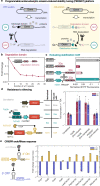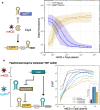PERSIST platform provides programmable RNA regulation using CRISPR endoRNases
- PMID: 35562172
- PMCID: PMC9095627
- DOI: 10.1038/s41467-022-30172-3
PERSIST platform provides programmable RNA regulation using CRISPR endoRNases
Abstract
Regulated transgene expression is an integral component of gene therapies, cell therapies and biomanufacturing. However, transcription factor-based regulation, upon which most applications are based, suffers from complications such as epigenetic silencing that limit expression longevity and reliability. Constitutive transgene transcription paired with post-transcriptional gene regulation could combat silencing, but few such RNA- or protein-level platforms exist. Here we develop an RNA-regulation platform we call "PERSIST" which consists of nine CRISPR-specific endoRNases as RNA-level activators and repressors as well as modular OFF- and ON-switch regulatory motifs. We show that PERSIST-regulated transgenes exhibit strong OFF and ON responses, resist silencing for at least two months, and can be readily layered to construct cascades, logic functions, switches and other sophisticated circuit topologies. The orthogonal, modular and composable nature of this platform as well as the ease in constructing robust and predictable gene circuits promises myriad applications in gene and cell therapies.
© 2022. The Author(s).
Conflict of interest statement
The Massachusetts Institute of Technology has filed patent applications on behalf of the inventors (B.D. and R.W.) for the RNA-ON switch platform described (US Provisional Application No. 16/049,042) as well as on behalf of the inventors (B.D., R.W., and N.W.) for the toggle switch described (US Provisional Application No. 17/122,087). The remaining authors declare no competing interests.
Figures





Similar articles
-
CRISPR transcriptional repression devices and layered circuits in mammalian cells.Nat Methods. 2014 Jul;11(7):723-6. doi: 10.1038/nmeth.2969. Epub 2014 May 5. Nat Methods. 2014. PMID: 24797424 Free PMC article.
-
CRISPR-based gene expression control for synthetic gene circuits.Biochem Soc Trans. 2020 Oct 30;48(5):1979-1993. doi: 10.1042/BST20200020. Biochem Soc Trans. 2020. PMID: 32964920 Free PMC article. Review.
-
Engineering synthetic TALE and CRISPR/Cas9 transcription factors for regulating gene expression.Methods. 2014 Sep;69(2):188-97. doi: 10.1016/j.ymeth.2014.06.014. Epub 2014 Jul 8. Methods. 2014. PMID: 25010559 Free PMC article.
-
High-Performance Allosteric Conditional Guide RNAs for Mammalian Cell-Selective Regulation of CRISPR/Cas.ACS Synth Biol. 2021 May 21;10(5):964-971. doi: 10.1021/acssynbio.1c00037. Epub 2021 Apr 30. ACS Synth Biol. 2021. PMID: 33930275
-
Engineering Synthetic Gene Circuits in Living Cells with CRISPR Technology.Trends Biotechnol. 2016 Jul;34(7):535-547. doi: 10.1016/j.tibtech.2015.12.014. Epub 2016 Jan 22. Trends Biotechnol. 2016. PMID: 26809780 Review.
Cited by
-
An engineered ligand-responsive Csy4 endoribonuclease controls transgene expression from Sendai virus vectors.J Biol Eng. 2024 Jan 16;18(1):9. doi: 10.1186/s13036-024-00404-9. J Biol Eng. 2024. PMID: 38229076 Free PMC article.
-
Orthogonal inducible control of Cas13 circuits enables programmable RNA regulation in mammalian cells.Nat Commun. 2024 Feb 21;15(1):1572. doi: 10.1038/s41467-024-45795-x. Nat Commun. 2024. PMID: 38383558 Free PMC article.
-
Targeted Control of Gene Expression Using CRISPR-Associated Endoribonucleases.Cells. 2025 Apr 3;14(7):543. doi: 10.3390/cells14070543. Cells. 2025. PMID: 40214496 Free PMC article.
-
Programmable mammalian translational modulators by CRISPR-associated proteins.Nat Commun. 2023 Apr 19;14(1):2243. doi: 10.1038/s41467-023-37540-7. Nat Commun. 2023. PMID: 37076490 Free PMC article.
-
Engineered poly(A)-surrogates for translational regulation and therapeutic biocomputation in mammalian cells.Cell Res. 2024 Jan;34(1):31-46. doi: 10.1038/s41422-023-00896-y. Epub 2024 Jan 4. Cell Res. 2024. PMID: 38172533 Free PMC article.
References
Publication types
MeSH terms
Substances
Grants and funding
LinkOut - more resources
Full Text Sources
Other Literature Sources
Research Materials
Miscellaneous

